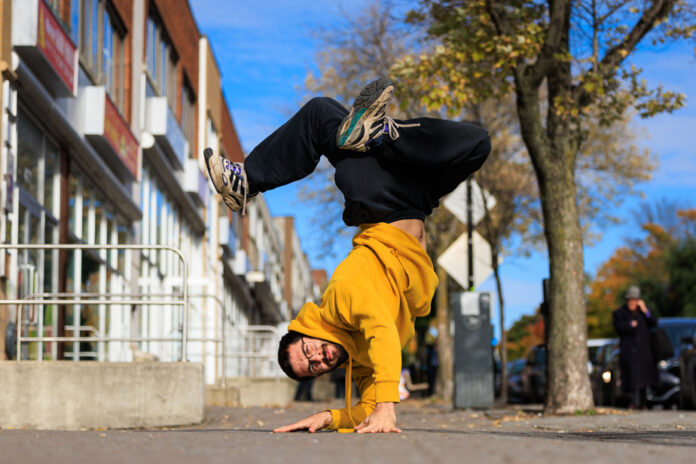Breaking was born in New York, in the Bronx, around forty years ago. At the time, “it was more hardcore,” explains Eric Zig Martel, who has been immersed in the breaking scene in Quebec for 30 years. Over the years, the man who once ran his own dance studio has seen the scene evolve and change.
Montreal had its style. Toronto and New York, for example, had theirs.
Over time, the internet has changed things; everyone has access to the movements and can train at home. The fact remains that each dancer has their own style, influenced by their experiences.
“A B-Girl who comes from the Bronx doesn’t have the same energy as a woman who comes from Saint-Sauveur. It’s more hardcore, more street. When she takes her break, there is a rougher side. A person who comes from a disadvantaged background will transmit their experience in their dance. »
Breaking is “infinitely hard,” says Samuel Mass Cyr. The dancers must not only perform movements and acrobatics, but also improvise them to music… while facing an opponent.
“You never know the music in advance,” Mass explains. Sometimes it’s classics, other times it might be a classic, but the DJ will remix it. »
All this, while being original, different from the others. A dancer can also decide to invent their own movements. “There are foundational moves that you need to use to understand the aesthetic of the break in general. But after that, there are no rules. »
Between toprocks (standing movements), footwork (ground movements), freezes (positions without movement) and power moves (acrobatics), there are no limits to breaking.
“The more you learn, the more you realize that, yes, it’s technical, but the goal is to be original,” notes Mass. It’s about discovering who you are, having your own style. It’s not like there’s a blueprint. […] We don’t want someone who is just technically good. We want someone who will be original, whose dance means something. Someone who is different. That’s hard. This is where art comes in. »
When it was announced that breaking would make its entry into the program of the Paris Olympic Games – however, it will not be at the Los Angeles Olympic Games in 2028 – Zig and several “old hands” got together. “We had to do something on a Canadian level, take charge of our own scene before someone else did,” he explains.
Breaking has often been a black sheep, the 46-year-old recalls. As the doors suddenly opened, it was important to the community that the “true” image and culture of breaking be preserved, respected. The big question went like this: “How do we minimize the impacts of having this very mainstream now, but keep the culture intact? »
For dancers, “it’s very clear that [breaking] is an art before being a sport,” says Samuel Mass Cyr. The competitive context, where there is a loser and a winner, also makes it a sporting discipline. But not every B-Boy or B-Girl is required to compete.
“There are so many paths you can take,” Mass says. You can do several or just one, it’s still a break. It is not because there is a new one that is more athletic and more professional that it invalidates all the others, that this one is not good. »
The arrival of breaking at the Olympic Games created a craze. Formerly underground, B-Boys and B-Girls are now much more seen. And that’s intentional.
“I think we’re there today. We’re ready to show it to everyone, said Zig. Especially in Quebec, with shows like Révolution, it shows our art in broad daylight. The people who participate, in station wagons among others, are real representatives of the underground who win competitions and who are real in what they do. It’s not just anyone. »
So where do Quebec and Canada stand on the international breaking scene? “We’re really good,” sums up Zig, who is one of those who gives a lot to the community in different ways. He is, notably, the director of the Distrix festival.
Still, breaking remains subjective, he recalls. “With Breaking Canada, my vision of what I see from the scene and what I’m trying to imply, I like the Canadian direction and what the rest of us are doing. »
“Do I care about how it looks today? Generally, around the world, no. What we do here, yes. In the world, it’s a break that doesn’t interest me, but that could interest anyone. A Korean who flies everywhere, who turns on one finger and does 18 turns, people will scream, but for me it’s something else. It’s an artistic approach…”
Note that Canada is counting on B-Boy Phil Wizard, from Vancouver, who has just obtained his ticket to the Paris Games thanks to his gold medal at the Pan American Games. “He’s the dude to beat in the world. »















